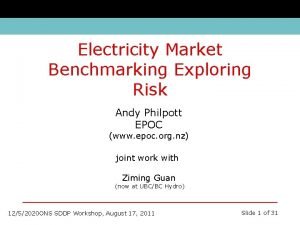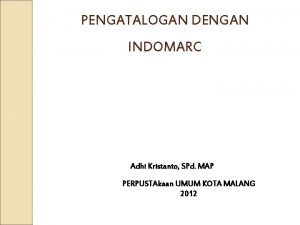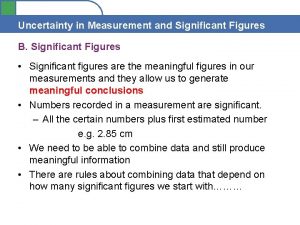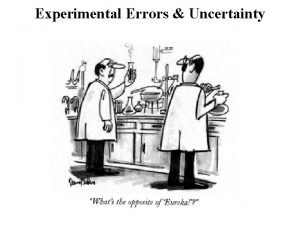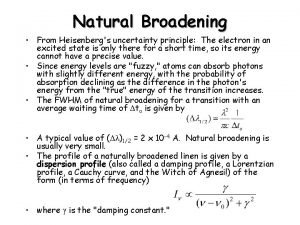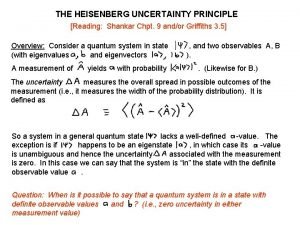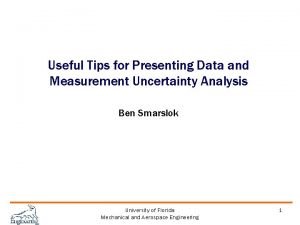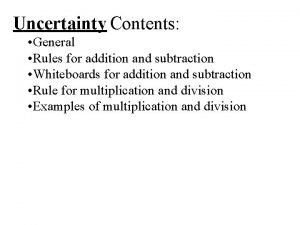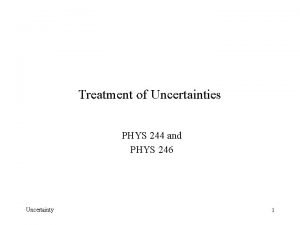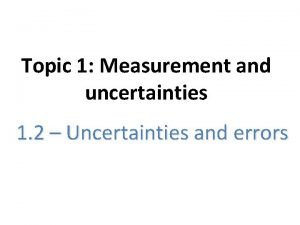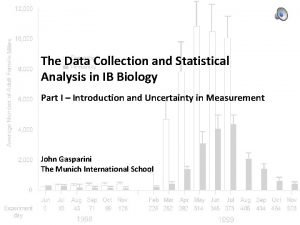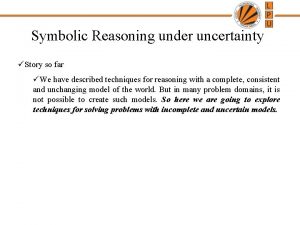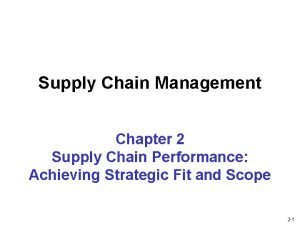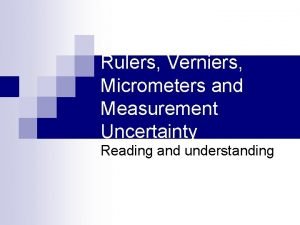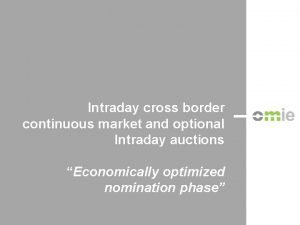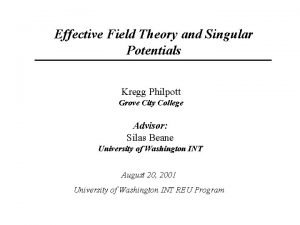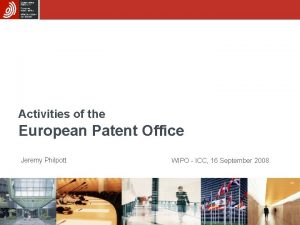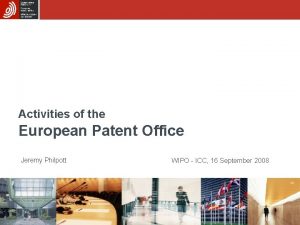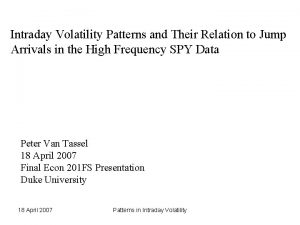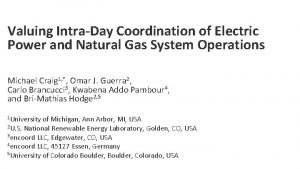SPD and Intraday Uncertainty PROF ANDY PHILPOTT DR



































- Slides: 35

SPD and Intra-day Uncertainty PROF. ANDY PHILPOTT, DR. GOLBON ZAKERI, NICHOLAS PORTER

Previous Works • A. B. Philpott and Z. Guan- Models for estimating the performance of electricity markets with hydro-electric reservoir storage (2013) • Approximated New Zealand’s transmission network as an 18 node model. • Compared historical dispatch to a centrally dispatched model with perfect information about demand inflows. • Fuel costs were 10% lower for the centrally dispatched model, when solved on a daily basis between 2005 and 2009. • These inefficiencies may be due to uncertainty in demand, market power or risk aversion. The exact cause is not clear.

Aim • Develop models for the offering, scheduling, pricing and dispatch of the New Zealand Electricity Market. • Assess the inefficiency caused by uncertainty in demand in the New Zealand Electricity Market. • Quantify the impact on efficiency caused by a day-ahead market.

Introduction • The New Zealand wholesale electricity market operates through a central pool. • Purchaser’s bids and operator’s offers are submitted through 48 half-hour trading periods. • Unlike most overseas market, New Zealand has no day-ahead energy trading.

Introduction • Advantages of a Day-Ahead market • It is more efficient to schedule unit commitment through a common pool over several trading periods. • Generator’s offers do not need to be distorted in order to manage unit commitment.

General Model Assumptions • These models are not strategic: generators offer into the market at fuel cost. The fuel cost for Hydro and Geothermal stations is assumed to be zero. • Unit commitment is neglected, and smooth convex quadratic functions are used for the hydro production functions and thermal cumulative cost functions.

Clairvoyant Model Formulation • Centrally planned solution, assuming that the demand is known for the day • The objective is to minimize the cost of fuel consumption over the planning horizon (Quadratic). • The network is constrained by upper bounds on transmission line flows, voltage angle constraints, and quadratic thermal losses. • The dispatch is constrained by the generators’ offers, ramping constraints, and demand for the system must be met. • Historical reservoir volumes are used as the starting point and the minimum endpoint for the planning horizon. • Conservation of mass constraints model the quadratic relationship between power generation and flow rate, as well as time delays between reservoirs. • The system is further constrained by limits on reservoir volume, ramping, spill, and generation. • Output: • Dispatch Schedule for the day. • Prices for the day

Comparison • The clairvoyant model produces a competitive equilibrium with perfect information. • In order to assess the effect of uncertainty in demand, we compare the results of the Clairvoyant model to a model that simulates a half-hourly offer and dispatch mechanism with uncertainty in demand.

Demand Forecasting • In order to model the intra-day uncertainty, a process of demand forecasting must be developed. • The initial demand estimate comes from averaged historical demands based on season and day of week. • As the true demand for a period becomes known, the demand for all subsequent periods is reforecasted. • Projected demand for all subsequent periods is increased or decreased by the difference between the actual demand the projected demand for the demand that has just become available.

Half-Hourly Dispatch Model • We have developed a model that simulates a half-hourly offering and dispatch process similar to that in the New Zealand Electricity model. • Unlike the Clairvoyant model, the demand is uncertain. • Within this model, there a few sub-models: • A river-chain optimisation for each offering hydro generator. • An SPD model

River Chain Formulation • The objective is to maximize the revenue across the planning horizon, given the provisional price vector. • Historical reservoir volumes are used as the starting point and the minimum endpoint for the planning horizon. • Conservation of mass constraints model the quadratic relationship between power generation and flow rate, as well as time delays between reservoirs. • The system is further constrained by limits on reservoir volume, ramping, spill, and generation. • Output: • Offers for SPD

SPD Formulation • The objective is to minimize the cost of fuel over the planning horizon (Quadratic). • The network is constrained by upper bounds on transmission line flows, voltage angle constraints, and quadratic thermal losses. • The dispatch is constrained by the generators’ offers, ramping constraints, and demand for the system must be met. • Outputs • Block Dispatch for the hydro generators. • Thermal Dispatch. • Prices.

Half-Hourly Dispatch Algorithm • The half hourly model is solved 48 times for a single day. • At each trading period the following steps are followed: • Hydro generators calculate offers by solving river chain problem maximising revenue using provisional prices. • Thermal generators offer maximum generation at fuel cost. Hydro generators offer their quantity at zero cost. • Current period’s actual demand becomes known, and demand for remaining periods is reforecasted. • System Operator solves SPD problem minimizing cost of fuel consumption over remaining periods. • Price for current period is set and SPD outputs new price signals. • Thermal Dispatch is fixed for current period • Hydro generation is allowed to be rearranged, provided the sum of rearranged generation is equal to the sum of the dispatch.

Network Assumptions • A subset of 8 nodes in the 18 node New Zealand transmission network is assumed for computational ease. • Reserve, frequency and n-1 security are neglected in this model. • A model with a larger network with more realistic constraints is being developed through v. SPD.

Experiment 1 • The first experiment involves direct comparison between the clairvoyant model and the halfhourly model. • The two models are compared over 16 winter days across 2008 and 2009. • Historical demand is used as the true demand for both models. • Average demand across sample days is used as the initial projected demand for the half-hourly model.

Experiment 1 Results • From this experiment, we see the total cost of fuel consumption is almost twice as high for the half-hourly model than it is for the clairvoyant model.

Experiment 1 - Aggregated Hydro Dispatch Total Hydro Dispatch(MW) 3000 2500 2000 1500 1000 500 0 1 3 5 7 9 11 13 15 17 19 21 23 25 27 29 31 33 35 37 39 41 43 45 47 Trade Period Half-Hourly Clairvoyant

Experiment 1 - Results Also of interest is cost to consumer. We see almost 12% higher cost to the consumer for the clairvoyant model compared to the halfhourly model.

Experiment 1 - WKM Half Hour Prices 45 40 35 30 25 20 15 10 5 0 1 5 9 13 17 21 25 Trade Period 29 33 Half-Hourly 37 41 45 Clairvoyant

Illustration of Pricing Phenomenon Consider a centrally planned clairvoyant dispatch model, run at a single node across two time periods with one thermal generator and one hydro generator. The problem is to manage the hydro and thermal dispatch over the planning horizon. Assumptions: • Two time periods and one node. • is thermal generation at period • Demand for period 1 is 2 MW and demand for period 2 is 2 MW • Hydro Generation = 2. 2 MW and thermal generation makes up the remaining 1. 8 MW • Cumulative Fuel Cost for thermal generator at period is given as • Cost of hydro generation is zero. Therefore, we assume that, if • If then , then the market price,

Illustration of Pricing Phenomenon Consider a case where the total cost of fuel consumption across both periods is being minimized: Setting Differentiating this and setting to zero we get: and This solution produces prices The total cost of fuel consumption is and the total consumer cost is

Illustration of Pricing Phenomenon Consider a case where This produces and The total cost to the consumer is and the cost of fuel consumption is This solution has a fuel cost that is 8. 2% higher than the solution on the previous slide. However, the cost to the consumer is 55% lower for this solution. This shows that minimizing the cost to consumers across the two trading periods does not necessarily produce an efficient dispatch.

Illustration of Pricing Phenomenon 1, 6 Marginalprice($) Marginal 1, 6 1, 4 1, 2 1 1 0, 8 0, 6 0, 4 A=2. 36 A=0. 981 0, 2 0 1, 1 01, 1 22 Generation(MW) Marginalprice($) Marginal 1, 6 1, 4 1, 2 1 1 0, 8 0, 6 0, 4 0, 2 0 0 0 A=2. 124 A=2. 72 2 2, 2 Generation(MW) 4 4 2 2

Experiment 2 • In order to smooth this dispatch, and allow for more consistent prices, we consider two approaches. • The first of these approaches is to tighten the ramping constraint on the hydro generators • For the same 16 days from experiment 1, the model is rerun with a ramping limit of 20% of maximum generation per hour.

Experiment 2 Results • By restricting the ramp rates, we see the fuel consumption cost is 23. 5% higher for the half-hourly model than it is for the clairvoyant model.

3000 1800 Total Hydro Dispatch(MW) Aggregated Hydro Dispatch(MW) Experiment 2 - Aggregated Hydro Dispatch 1600 1400 1200 1000 800 600 400 2500 2000 1500 1000 500 0 0 1 5 9 13 17 21 25 29 33 37 41 45 Trade Period Clairvoyant Half-Hourly 1 5 9 13 17 21 25 29 33 37 41 45 Trade Period Half-Hourly Clairvoyant

Experiment 2 - Results Restricting the ramp rate made the cost to the consumer 9. 1% higher for the half-hourly model than compared to the clairvoyant model.

Experiment 2 - WKM Half Hour Prices 45 35 40 WKM Prices($/MWH) 30 25 20 15 10 35 30 25 20 15 10 5 5 0 0 1 5 9 13 17 21 25 29 Trade Period Clairvoyant 33 Half-Hourly 37 41 45 1 5 9 13 17 21 25 29 33 37 41 45 Trade Period Half-Hourly

Experiment 3 • The second approach to smoothing the results is to model a contract that stipulates the minimum amount each hydro generator must offer at each trade period. • In this experiment, we looked at two particular days and simulated 20 demand scenarios for each. • The days are the same day of the week, and are both winter days, so have the same initial projected demand • In order to find the amount of generation to be contracted, a central plan is solved using an average historical demand. • The contracted hydro generation for each generator is then set to 80% of the generator’s total hydro generation from the central plan. • The demand scenarios come from a normal distribution based on historical data. • Compared the clairvoyant and halfhourly models with and without the generation contract. • The averaged historical demand is used as the initial projected demand.

Experiment 3 For the first day, without a generation contract we see a 22. 1% higher cost of fuel for the halfhourly model than for the clairvoyant model. Including a contract drops the difference in consumption to 1. 8% For the second day, without a generation contract, we see a 500% higher cost of fuel for the halfhourly model than for the clairvoyant model. Instituting a contract drops the difference in consumption to 165%

Experiment 3 - Day 2 Results Aggregated Hydro Dispatch (MW) Why do we such a big difference between the two models on the second day? 2500 2000 1500 1000 500 0 1 3 5 7 9 11 13 15 17 19 21 Day 1 23 25 27 Trade Period 29 31 33 35 37 39 41 43 45 47 Day 2 Plenty of water for the second day results in very low cost for the clairvoyant solution.

Experiment 3 - Day 1 Results Looking at a single scenario of experiment on Day 1. 2500 2000 1500 1000 500 0 1 3 5 7 9 11 13 15 17 19 21 23 25 27 29 31 33 35 37 39 41 43 45 47 Trade Period Clairvoyant Half-Hourly Without Contract Aggregated Hydro Dispatch(MW) Aggregated Hydro Dispatch (MW) With Contract 3000 2500 2000 1500 1000 500 0 1 3 5 7 9 11 13 15 17 19 21 23 25 27 29 31 33 35 37 39 41 43 45 47 Trade Period Clairvoyant Half-Hourly

Experiment 3 - Consumer Cost For the first day, without a generation contract we see a 19. 8% higher cost to the consumer for the clairvoyant model than for the half-hourly model. Including a contract drops the difference in consumer cost to 1. 4% For the second day, without a generation contract, we see a 10. 6% higher cost to the consumer for the clairvoyant model than for the half-hourly model. Instituting a contract drops the difference in consumer cost to 6. 2%

Experiment 3 - Day 1 Results WKM Half Hour Prices With Contract 40 35 30 25 20 15 10 5 0 1 2 3 4 5 6 7 8 9101112131415161718192021222324252627282930313233343536373839404142434445464748 Halfhourly Clairvoyant WKM Half Hour Prices Without Contract 45 40 35 30 25 20 15 10 5 0 1 2 3 4 5 6 7 8 9101112131415161718192021222324252627282930313233343536373839404142434445464748 Halfhourly Clairvoyant

Conclusions • Too early to make conclusions about the effect of inflexibility to demand uncertainty. • Minimizing fuel cost does not necessarily minimize the cost to the consumer. • Tightened ramping and contracted generation provides us with smoother and more intuitive dispatch schedules. • Tightened ramping especially provided more intuitive customer costs
 Andy philpott
Andy philpott Hupx intraday
Hupx intraday Sue philpott
Sue philpott Dominique cottrez
Dominique cottrez Jane philpott education
Jane philpott education Spd periodic table
Spd periodic table Spd bilddatenbank
Spd bilddatenbank Spd protection
Spd protection Spd 2
Spd 2 Spd map
Spd map Significant figures rules
Significant figures rules Risk and uncertainty continuum
Risk and uncertainty continuum Is it real issue with genuine controversy and uncertainty
Is it real issue with genuine controversy and uncertainty Low and high uncertainty avoidance
Low and high uncertainty avoidance Risk and uncertainty difference
Risk and uncertainty difference Laray m. barna (1997)
Laray m. barna (1997) Uncertainty multiplication and division
Uncertainty multiplication and division Experimental error definition
Experimental error definition Chapter 13 mass society and democracy
Chapter 13 mass society and democracy Measurement uncertainty
Measurement uncertainty Natural broadening
Natural broadening Capital budgeting under risk and uncertainty
Capital budgeting under risk and uncertainty Risk and uncertainty in farm management
Risk and uncertainty in farm management Calculate certainty equivalent
Calculate certainty equivalent State and prove heisenberg uncertainty principle
State and prove heisenberg uncertainty principle Random uncertainty
Random uncertainty What are significant figures
What are significant figures Uncertainty in subtraction
Uncertainty in subtraction Random uncertainty
Random uncertainty How to calculate the percent difference
How to calculate the percent difference Smallest measurement of time
Smallest measurement of time Triple beam balance uncertainty
Triple beam balance uncertainty Minimalist reasoning
Minimalist reasoning Implied uncertainty spectrum
Implied uncertainty spectrum Managing innovation within firms
Managing innovation within firms Reading
Reading
